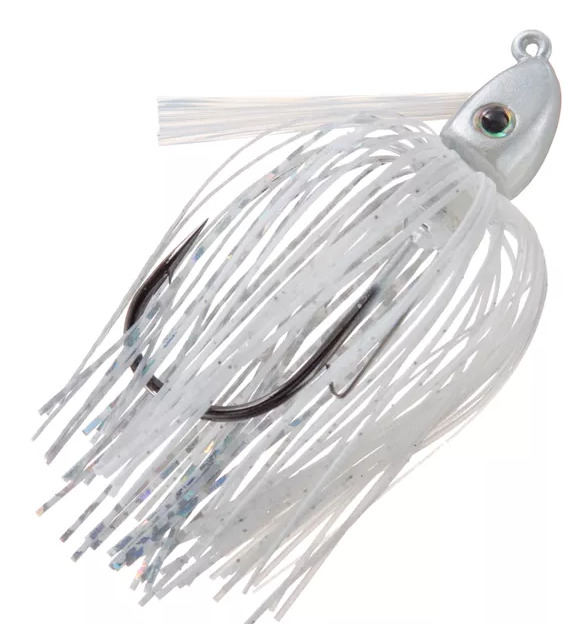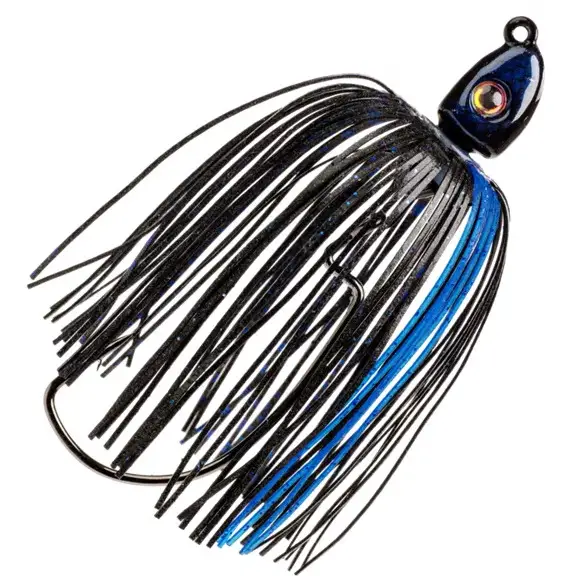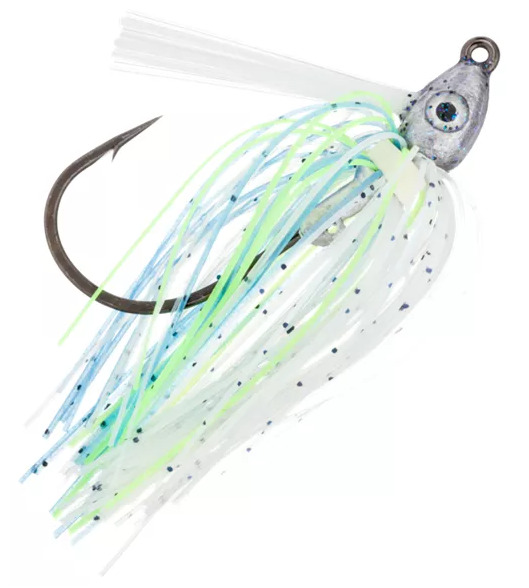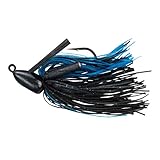How To Fish A Swim Jig For Bass
The market for swim jigs continues to grow and gain in popularity with new people getting into bass fishing. So with all the different variations, how do you fish a swim jig for bass? What’s the best way? Answered simply, a swim jig is a popular lure for targeting suspended bass, or bass in areas with heavy cover, but what many anglers fail to realize is that it can be so much more.
We’ve constructed this blueprint for you to evaluate all the ins and outs of the various swim jig designs and features found in today’s offerings, then coupled with the most up to date techniques on where and how to fish this lure.
Only then you can take a tactical approach in choosing the best product for your needs and budget since it will dramatically impact your decision.
Price has grown along with technology throughout time. With you in mind, we spent hundreds of hours researching and evaluating and interviewing some of the best anglers fishing right now in order to give you a comprehensive guide to help you catch the most fish using a swim jig.
WARNING: There’s a lot of information about this subject you’ll probably want to come back to. No one expects you to remember all these tips. We know your time is precious, so we really tried to over-deliver in value for you. Additionally, we frequently update reports like this, so you’ll want to stay up to date with any changes or additional tips we include for you.
We found that the easiest way to save and bookmark this report so you can come back to it later is to share it on your favorite social media platform, especially if you use your phone to get important tips like the ones in this report here…
Click on your favorite social media buttons to remember this page now!
What is a Swim Jig and Why Would a Fish Bite It?
Below is a brief description of a swim jig and it’s basic features. If you feel comfortable with this topic, scroll to the next section. Ok lets get started…
Swim jigs are designed for swimming through the water rather than bouncing across the bottom. The head of the swim jig is pointed and typically includes a vertical line tie for traveling through the water column and slipping through cover.
A skirt wraps around the collar of the jig and flares out to help create a more natural presentation. The skirt pulses, which resembles the movement and flash of a fish’s fins and scales.
The movement of a swim jig mimics baitfish swimming. Bass go after swim jigs as they resemble their standard prey.
Depending on the colors, sizes, and retrieval technique, swim jigs may imitate crawfish, shad, bluegill, and anything else that bass may eat.
What Are the Different Types of Swim Jigs?
One consideration is whether to use a weedless swim jig or leave the hook exposed. Weedless swim jigs include a weed-guard, which helps shield the hook by deflecting weeds and vegetation as your lure swims through the water.
Some anglers feel that the weed guard limits strike-to-hookset ratios. However, most would agree that the weed guard is necessary for fishing in weedy areas.
Swim jigs are also available in various sizes. The most common options for bass include 1/4-ounce, 3/8-ounce, and 1/2-ounce jigs.
A 1/4-ounce swim jig is good for swimming the jig near the surface and top few feet of the water column. A heavier swim jig can tear through grass easier and sink to lower depths faster.
You may want to use a 1/4-ounce swim jig in depths up to a few feet and in light grassy areas. Use a heavier jig in heavier vegetation or for depths beyond a few feet.
How To Fish A Swim Jig? Best Retrieval Techniques...
Before we get down and dirty talking about techniques, keep in mind you can also switch back and forth between the techniques you’re about to learn. Mixing up your tempo can also trigger more fish to strike.
Basic Swim Jig Retrieval
The basic retrieval technique for swim jig fishing involves a moderate, but steady once your gets to the bottom, or falls to the desired depth.
A steady reel works when you intentionally run into thick pockets of grass or hard structure for it to deflect off of.
The straight retrieval allows the swim jig to imitate swimming baitfish. However, you can also allow your lure to sink a little or randomly jerk your rod to add spontaneous movement and trigger reaction strikes from nearby bass.
For example, after pulling your swim jig through some weeds or grass, allow it to sink for a split second. The skirt should flare out momentarily before you resume reeling it in.
You can also swim the jig back to your boat slowly or quickly. A faster retrieval keeps your jig higher up in the water column while a slower retrieval may cause your jig to sink.
The Burn
There’s two categories of burning a swim jig.
 Burn Tip #1: Initiating a fast retrieval keeps the lure towards the surface of the water, which forms a “V” shaped wake if you reel it in fast enough. A faster retrieval is often used in clearer conditions and open areas. The most common size for this technique is going to be a lighter ¼-ounce swim jig.
Burn Tip #1: Initiating a fast retrieval keeps the lure towards the surface of the water, which forms a “V” shaped wake if you reel it in fast enough. A faster retrieval is often used in clearer conditions and open areas. The most common size for this technique is going to be a lighter ¼-ounce swim jig.
However, if you reel the swim jig in too fast it will naturally roll on its size and will cause you to lose bites.
To help you bulk up the lure add a fat swimbait like the Keitech Swing Impact FAT Swimbait 4.3.
Burn Tip #2: If you know the bass are chasing shad but are on deeper structure, choose a heavier ½-to-¾-ounce swim jig, remove the skirt and replace it with a narrow swimbait, such as a Megabass Spark Shad.
The Drag
Many anglers don’t use this technique because they fear losing their jigs, however if you’re using a weedless jig you shouldn’t have any trouble.
Thread on your favorite fluke bait and drag it over or off of any ledges or drop offs.
Personally I’ve only had success with this when fishing ledges, bluff walls, and drop offs. But who knows you may have a different result!
The Hop
When the water temperature rises into the 70s and 80s in May, June, or July, play with variations of hopping your swim jig. Start by just raising and dropping your jig. This is especially important if you’re fishing in a river with current. Then if you get no bites, snap the tip of your rod up a few inches to make up pop-hop off the bottom and let it drop to the bottom.
When there’s a lot of current flow, hopping a jig is critical.
It’s a good idea to keep an eye out for schools of bass when you’re fishing, and one of the best ways to do this is by dragging your swim jig or football jig along a ledge or point. Then if they stop biting, throw out your jig, pop it off the bottom and you might actually elicit a few extra bites from otherwise uninterested fish.
Swim Jig on the Bottom
You can technically fish a swim jig on the bottom, especially when you’re fishing a lake with bottom dwelling fish like gobies.
Simply cast out and reeled back in. However, pay close attention to bump your jig into the structure to trigger reaction bites.
In this specific situation make sure to use a paddle tail swimbait rigged upside down – meaning the boot tail is facing up.
OH MY GOSH! I ALMOST FORGOT!.. Here’s a solid night fishing tip…. Thread on a wide body crawfish trailer and slowly fish it on the bottom.
Not only does the wide-body craw help keep the hook upright (to avoid getting snagged) when swimming this along the bottom, but it also provides a flat bottom and a large surface area giving it a ton of vibration.
5 Great Locations and Structures to Fish a Swim Jig for Bass
Swim jigs are primarily used in shallower areas, ranging from just a few inches to up to 6 feet below the surface. Some of the best locations and structures to fish a swim jig include:
- Shallow grassy areas
- Rocky shorelines
- Drop-offs and humps
- Open flats
- Points
Shallow Grassy Areas
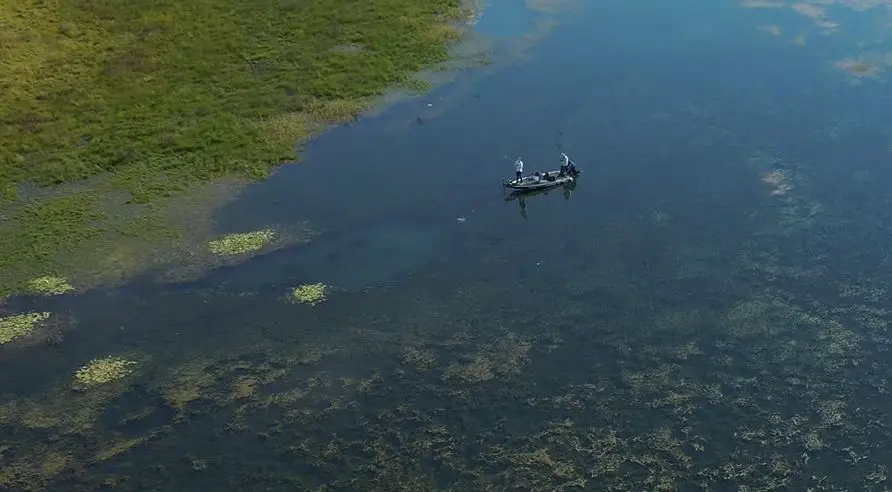 Shallow areas with light to heavy vegetation are the most common areas to use a swim jig. No other jigs offer the same weedless design, which is why swim jigs are perfect for fishing in and around areas with heavy cover.
Shallow areas with light to heavy vegetation are the most common areas to use a swim jig. No other jigs offer the same weedless design, which is why swim jigs are perfect for fishing in and around areas with heavy cover.
Use a light swim jig around the edges of weedy areas and a heavier jig to rip through the weeds. Some anglers prefer to prepare two or more rods for different situations, such as a light rig for open water and light cover and a heavier rig for thick weeds.
If you arrive at a lake or river with heavy pressure from other anglers, consider using a heavy rig in grassy areas. Most other anglers are likely to stick to the outer edges and lighter vegetation unless they’re also using swim jigs.
Ripping a 1/2-ounce swim jig through thick weeds when everyone else is sticking to the outer edges can help you land bigger bass.
You should also look for irregularities in areas of vegetation. Irregularities include changes in vegetation, such as the open area around a V-shaped section of grass.
The bass often hide in the areas around irregularities. Ripping a swim jig through these areas may help you attract aggressive strikes.
Rocky Shorelines
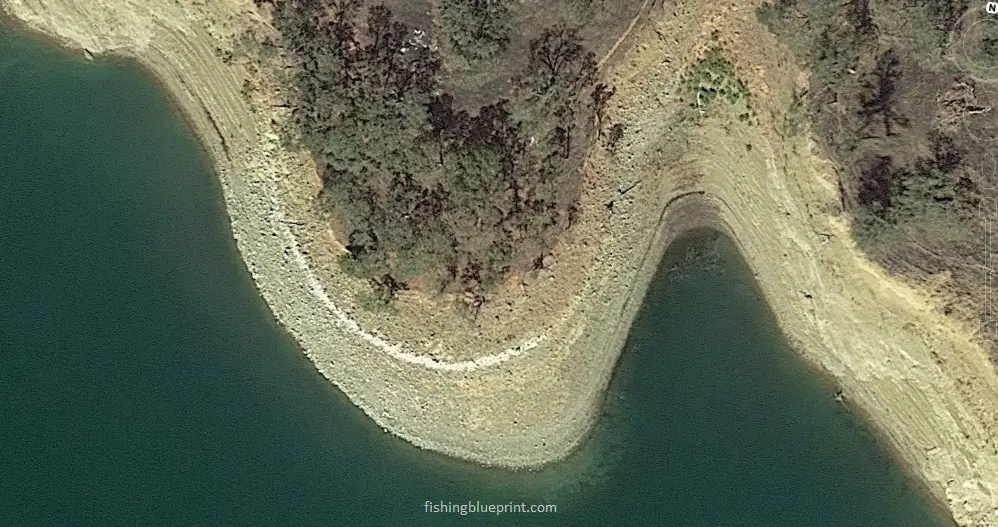 After shallow grassy areas, rocky shorelines are the best areas to use a swim jig. The bass often move toward shallow, rocky areas before and during the spawning stage in the spring.
After shallow grassy areas, rocky shorelines are the best areas to use a swim jig. The bass often move toward shallow, rocky areas before and during the spawning stage in the spring.
Use a smaller jig when fishing around big rocks. Large rocks can create larger crevices that may catch heavier jigs.
You should also find it easier to keep a lighter swim jig toward the top of the water column and away from crevices. Using a fast reel can also help with your retrieval when trying to avoid the bottom.
If the area where you fish has crawfish, try adding a craw trailer to your swim jig and fishing in the rocky areas near shores and creeks. The bass are especially likely to react aggressively when swimming a craw trailer over their spawning grounds.
If you’re new to a lake or river, you can check satellite imagery and maps to pinpoint rocky outcrops. The shallow, rocky areas often appear as darker patches compared to the surrounding water.
Drop-Offs and Humps

The perimeter of a drop-off or a hump can provide the perfect opportunity to catch bass with a swim jig, especially if the structure includes vegetation.
In the graphic above, is a hump (A), which is kinda like an underwater island while a drop-off (B) occurs when there is a sudden drop in the water depth.
Both types of structure tend to provide food for fish in the area. The baitfish search the tops of humps and the shallow areas near the tops of drop-offs for food while the bass suspends in deeper water.
The crest of a hump or the ledge of a drop-off may sit several inches up to 20 or 30 feet below the water. When using a swim jig, you’re typically looking for humps and ledges up to 5 or 6 feet deep.
Smallmouth bass may move toward the tops of humps in low-light conditions and retreat toward the edges when the sun comes out.
Open Flats
 Shallow, open flats are a good spot to search for bass with a swim jig if you don’t have luck near areas with cover.
Shallow, open flats are a good spot to search for bass with a swim jig if you don’t have luck near areas with cover.
Flats typically have a depth of 3 to 10 feet and may be found near the shore and even near the middle of a lake. Some flats are a few dozen yards across while others stretch for a mile or longer.
While the bass typically look for grassy areas where baitfish are likely to hide and find food, you can find scattered bass in open flats with less cover. The bass may move to open flats when light levels are low, such as early in the morning or late in the evening.
Points
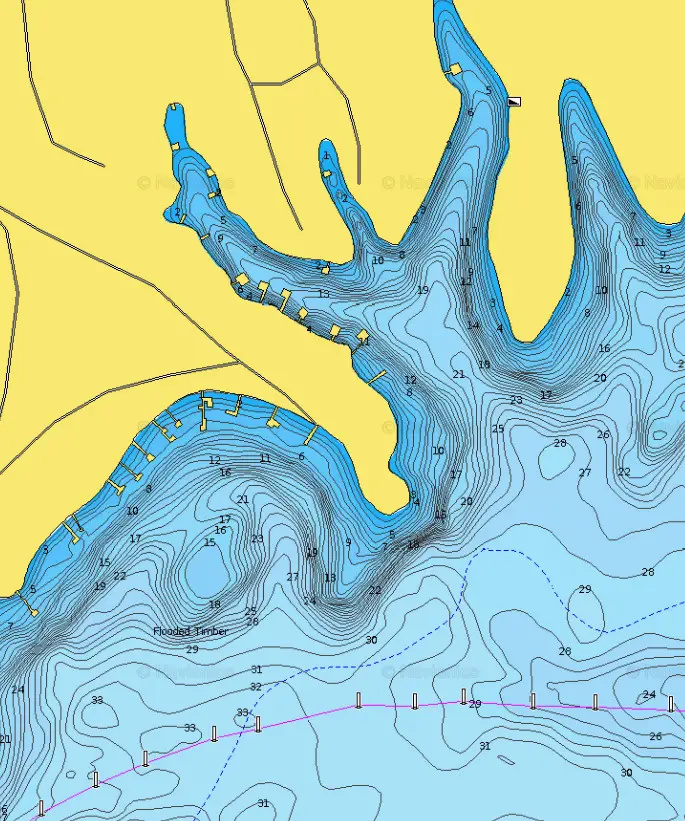
Points allow the bass to quickly access both shallow and deep water, which provides you the chance to find the bass with a swim jig almost any time of the year. You should first try targeting the shallower areas near the top of the point.
You’re less likely to spook the bass in the shallow areas if you stop your boat in the deeper water and cast toward the point. You should also complete multiple casts in the same area before moving on to another part of the point.
After targeting the top of the point, move to the sides. The sides of points are where you’re likely to find less aggressive bass.
After swimming the jig around the sides of the point, head toward deeper water. Look for any sudden transitions in the depth of the water, such as a small drop-off or hole that can provide cooler water for the bass.
Recommended Swim Jigs...
With all the current choices on the market here are some swim jigs you need to consider…
– Winner! –
Strike King Hack Attack Heavy Cover Swim Jig
Designed for fishing in and around the heaviest cover, Strike King®’s Hack Attack Heavy Cover Swim Jig is built around an exclusive Gamakatsu extra-strong Siwash hook for extra bite.
A heavy weed guard helps it to negotiate the heaviest cover, and a Perfect Skirt™ adds a more lifelike action.
If you’re hauling big fish out of grass or wood, this is the jig for you!
- Colors: 5
- Sizes: 2
- Hook: Gamakatsu extra-strong Siwash hook
- Ergonomic and perfectly balanced for all day use
- Trusted by professional anglers worldwide
- Limited colors
– Runner Up –
Strike King Tour Grade Swinging Swim Jig
Look closely at the Strike King® Swinging Swim Jig, and you’ll see that unlike other jig styles, it’s not built on a fixed hook.
Instead, it has an eye joint that allows the hook to swing freely as the jig moves through the water, creating a supple swimming action beyond that of any other jig.
The sleek, perfectly balanced swimming head was designed by the Strike King Pro Staff to slice through the water with ease, causing the Perfect Skirt® to ripple and shimmer along; simply add your favorite plastic trailer to the swinging hook, and see what Tour Grade “maximum action” can do for your catch rate!
Black nickel Needlepoint hook.
- Colors: 3
- Sizes: 2
- Hook: standard
- Ergonomic and perfectly balanced for all day use
- Trusted by professional anglers worldwide
- Retailer runs out quickly
– Editors Choice –
Nichols Lures Saber Swim Jig
Handcrafted quality spells the difference when the Nichols Lures Saber Swim Jig hits the water.
This meticulously built bass jig is built with an upswept head for super realism as it courses through the undergrowth, with its supersoft skirt pulsating and flaring with every movement.
The metal flake head features 3D eyes and is molded on a premium Mustad® UltraPoint® 3X hook with 30° bend for maximum control; sturdy fiber brushguard handles the thick stuff with ease.
Fish with or without a trailer; patented toothpick keeper holds plastic firmly in place.
- Looks amazing
- Upgrades added without an increase in price
- Relatively balanced
- 30-day warranty
- Colors: 11
- Sizes: 1
- Hook: standard
- Ergonomic and perfectly balanced for all day use
- Trusted by professional anglers worldwide
- Only one size offered
Check Out These Amazon Best Sellers...
- Exclusive Gamakatsu extra-strong Siwash hook
- Perfect Skirt
- Heavy weed guard
- Designed by Strike King's Pro-Staff to help you catch more fish
- Includes a streamlined balanced head for better swimming action
- Head is painted and coordinated with the awesome Perfect Skirt
- Includes a medium wire ultra sharp hook
- Try a Rage Tail craw or the new Baby Rage Craw as a trailer and hold on; Bass love em'!
- WEED GUARD DESGIN: Penetrates brushpiles and drop through grassbeds with equal efficiency
- JIG FEATURES: Flat-bottom 18-degree rise, black nickel light wire hook
- ATTENTION SEEKER: Baby Boo Jig has a proven record of catching the big ones
- EFFECTIVE SIZE AND COLORS: 60-strand ultra fine silicone skirt patterns; 5/16 oz lure weight
- TOUGH AND DURABLE: Strong hard coat paint with Plasti-Keeper Spike
- GET SWIMMING; Reaction Tackle’s tungsten swim jigs for bass fishing are crafted specifically for open freshwater spaces; Reeling your swimming jig lure slowly through the water creates a natural pattern of baitfish movement that’s impossible for predators to ignore; Give yourself an unfair advantage with our realistic bass swim jigs
- LIFELIKE PRESENTATION; With high quality silicone skirts, Reaction Tackle’s bass fishing jigs have a vibrant and lifelike underwater presentation; More than simply finesse jigs for bass fishing, our fishing lures also make great pike, muskie and walleye jigs
- WEED PROTECTION; People love our bass jigs for the practical touches we add to our fishing equipment; Each one of our jig heads features weed protection to allow your jigs for bass to pass through weeds with less snags; Spend less time tangled and more time doing what you love with Reaction Tackle’s weedless jig heads
- TUNGSTEN HEAD; Our bass fishing gear features tungsten jig heads for extra sensitivity; With 97 percent pure tungsten, each of our fishing jig heads lets you feel every rock, weed, strike and hit; Upgrade your bass fishing to a more tactile experience with Reaction Tackle’s tungsten jigs
- QUALITY; Each bass fishing jig has undergone stringent quality inspection and hours of development with professional anglers; Our fishing equipment and supplies are crafted to the highest standards; The Reaction Tackle promise is this; if we wouldn’t use these tungsten fishing jigs ourselves, we won’t sell them
- Total 20 Pieces of One Pack:10 Pieces of Bass Fishing Jigs(3/8oz),10 Pieces of Jig Skirts(50 Strands,5.12 inch)
- Croch Jig Skirts are made of 100% silicone, each strand contains tiny pearl flakes for added attraction
- Ideal Jigs for Flipping, Skipping, or Fished as a Swim Jig
- Quick change jig skirts replacement rubber skirts, dress up with your lures
- Good quality will be your better choice
#ad / Images from Amazon Product Advertising API
Best Swim Jig Colors and Why
White is a popular choice in the spring and fall, as it more closely mimics shad. Natural colors are often used in clear water.
Black, blue, and other dark colors are frequently used in low light conditions or in stained water. Chartreuse, orange, and other bright colors are preferred for muddy, dingy water.
You may also want to pay attention to what other anglers are throwing. For example, white is a common choice, but if everyone uses a white swim jig, switching to a different color may help your fishing rig stand out.
The bass can become conditioned to seeing the same jigs all day and may lose interest. Even if you’re the only one on the water, you may want to switch colors if you’re not having luck.
Soft Plastic Trailer or Trailer Hook? Which is Better?
Adding a soft plastic trailer to a swim jig creates a larger profile and adds more movement to your fishing rig. Trailers come in a variety of styles, including crawfish, swimbait trailers, and grubs.
Crawfish trailers are good for targeting shallow, rocky areas in rivers or lake shorelines. Swimbait trailers are better in depths of 4 to 6 feet, as they don’t have as much lift as crawfish trailers.
Soft plastic trailers provide secondary action for a more natural presentation without the need to jerk or pump your rod during retrieval. The swimbait or crawfish trailer helps your swim jig appear more lifelike and attract more bass.
Some swimbaits include rigid bodies that help add more of a rocking motion to the body instead of just adding the side-to-side tail action. The extra action also allows the skirt to pulse more, adding more realism to your presentation.
Soft plastic trailers also come in various colors. Choose the color based on the forage.
For example, you can buy swimbait trailers in shad or bluegill colors.
A trailer hook trails behind the main hook to increase your chances of hooking a bass when they take a bite. Adding a trailer hook isn’t a common choice when using a swim jig, as it isn’t typically necessary.
A trailer hook can also get caught in weeds, eliminating one of the benefits of using a swim jig. You shouldn’t need to worry about using a trailer hook when using a swim jig with a good trailer, as the bass will ingest the swimbait without a problem.
What Size Trailer for Swim Jig is Best?
Swimming Trailers
The best size for soft plastic trailers is typically between three and five inches. Long swimbaits may increase your casting distance and add more tail action to your presentation for attracting aggressive bass.

You should also consider the size of the swim jig. A 4.5-inch swimbait on a 1/4-ounce swim jig may make your rig unbalanced while a 3-inch swimbait on a 1/2-ounce jig may not produce enough action.
One of the best swimbaits out there is a Keitech Swing Impact FAT Swimbait 4.3 is great to imitate gizzard shad or bluegill. However, if you have smaller baitfish in your lake such as threadfin shad you may want to go with a swimbait with a smaller paddle tale such as a Megabass Spark Shad 4″.

The last swimbait trailer that should be in your tackle box is a segmented swimbait trailer. Segmented swimbaits such as; the Lake Fork Magic Shad or the Yamamoto Zako.
If the trailer is too short, it won’t produce the roll and tail action you expect. A 3.5-inch to 4-inch swimbait should be ideal for most situations, but you can experiment with longer options if you want your rig to wobble and roll more.
Flapping Trailers
When bass are eating up crawfish switch to a crawfish bait that are big on action but small in profile.
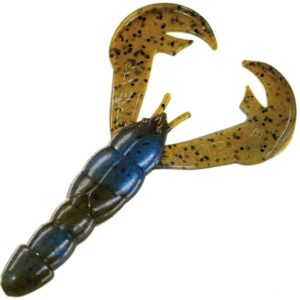
The Strike King Rage Craw, The Googan Krakin’ Craw’s, or the Berkley Powerbait Chigger Craw all have phenomenal action even at the slowest of retrieves.
Now when you add a soft plastic craw trailer it totally gives the lure a completely different feel on the retrieve. The trailer gives the lure a bulkier appearance and you’ll quickly notice you can’t fish it very fast.
Trailers that are in-between
Lastly, if bass want something in between (like during the bluegill spawn) you’re going to need a bait called a swimming-craw bait.

And one of the best baits that come to mind is the Zoom Super Speed Craw.
The Zoom Super Speed Craw is the perfect bait for this situation because the body is the perfect length, so you don’t have to do any trimming.
What’s even better, is you don’t have to remove the antenna appendages off the bait, I feel they just get in the way and neuter the action.
What's The Best Swim Jig Setup: Rod, Reel, and Line?
Rod
A rod measuring 6’8” to 7’6” is often used for swim jig fishing for bass.
A 7-foot rod offers a good middle ground between shorter and longer rods, making it well-suited for most swim jig fishing techniques. A shorter rod tends to work better for skipping the swim jig around docks and deep cover where you need more accuracy.
A longer rod works better for casting long distances. However, if the rod is too long for your comfort, you may struggle to control your swim jig, especially when reeling in large bass.
Most anglers choose a rod with medium-heavy power and fast action. A medium-heavy rod is more versatile and works well with a light lure while fast action increases your chances of successfully hooking bass with a single hook when using a swim jig.
But if you really want to get the most out of fishing a swim jig you go with a medium-heavy casting rod like a St. Croix Victory Series 7’5″, Medium-Heavy backbone, Fast action tip, they nicknamed the “Max Marshal“.
>>> Click HERE to read the reviews from actual customers about this rod! <<<
This style rod was specifically designed for the serious bass fishing enthusiast according to many reviews.
The rod has great strength and relatively soft, but sensitive tip that make it easy feel the vibration of the blade, detect even the softest of strikes, and the confidence to pull bass out of thick weeds and grass.
It is durable and lightweight with a tip made for strength and sensitivity.
If you’re more on a budget, I recommend a dependable economy casting rod that’s believed by many anglers to be the best casting rod for a beginner. It is low-priced yet it can fish a lot of bass.
Reel
Anglers also tend to use a high-speed reel with swim jigs. Beginners may want to start with a 7:1 or more gear ratio.
A 7:1 to 8:1 gear ratio allows you to wind in your fishing line faster, which makes it easier for the trailer to start moving so they can generate adequate commotion.
So I recommend using a quality Shimano casting reel to use with either of these rods. Most anglers choose a higher-speed gear ratio of 6.6:1 or higher.
>>> Click HERE to read the reviews from actual customers about this reel! <<<
I forgot to mention, a higher speed reel is preferred because if the bass are in cover or deep in the vegetation you don’t want them to wrap themselves around anything that’s going to cause you to break off your lure and lose the fish…
You need to get the bass out fast and that is what a fast reel does.
Line
Fluorocarbon, and braided fishing lines are all suitable for use with swim jigs.
There are two groups that debate which is the best line to use.
Some anglers like to use straight braided fishing line in 50-to-65-pound test strength.
Braided fishing line is strong and doesn’t stretch. The strength of a braided line is useful when fishing near weeds and cover.
Even though braided fishing line floats, over longer casts it can sometimes cause the lure to swim a little higher in the water column. In fact it can sometimes help by keeping the lure swimming above any submerged grass or structure.
Braided line is also 100% visible underwater. However, if you’re fishing in really thick cover the line blends in very easily.
Another good thing since your bait doesn’t have any blades (like a ChatterBait, spinnerbait, or underspin jig) the braided line won’t wrap around anything to foul your casts.
The other group likes to use only fluorocarbon line in stronger test limits, 15-25-pound test (depending on cover).
Fluorocarbon line sinks, but is very strong, has very little stretch and is nearly invisible underwater. Unfortunately, its about 3x as expensive than braided line. Lastly, in my opinion, it doesn’t cast as far as the braided line.
Personally, I belong to the fluorocarbon group… here’s why…
The lakes in the west are pretty clear and they don’t have a ton of vegetation, so I need that thick fluorocarbon line.
If you’re fishing clear’er water lakes then I personally use fluorocarbon line, 15-pound test, but if the cover is heavy I’ll go with 20-pound test.
How to Set the Hook When Fishing a Swim Jig
Pay close attention to avoid missing the moment that a bass strikes at your jig. You may either feel when a bass bites your jig or notice that the slack on your line suddenly disappears as the bass takes off.
Continue reeling in your line at the same steady speed that you were using before you noticed the strike, instead of trying to instantly set the hook. After you’ve reeled in most, but not all, of the slack on the line, pull the rod to the left or right to set the hook.
Other Bass Fishing Articles Just For You...
Selecting Early Summer Bass Fishing Lures [Avoid 5 Common Mistakes]
A Complete Buyer’s Blueprint On The Best Early Summer Bass Lures On The Market Today! When it comes to bass fishing, choosing the right lure
Early Summer Bass Fishing [Avoid These 3 Sneaky Lies]
Learn these closely guarded secrets early summer bass fishing … and… dramatically boost your advantage over other anglers! Late spring to early summer bass fishing
Fear The Finesse? 7 Ned Rig Fishing Secrets Exposed!
Conquer the Fear of Finesse… and… Unlock the Potential Ned Rig Fishing – TODAY! Fellow Angler… Like most of you I’m pretty set in my
Fishing Spawning Bass [18+ Lures & Gear]
Get Ready For The Spawn Now When bed fishing, stealth is of the biggest essential tip. Instead of racing forward with a trolling motor, anglers
[2023 Editors Choice] Picking The Best Bass Fishing LINE For ANY Budget
What is the best bass fishing line? | What is a good fishing line for bass? The best type of bass fishing line is based
Drift Sock Basics – What It Is A Drift Sock & How To Use It [2023 Quick Start Guide]
What Does A Drift Sock Do? | Why Use A Drift Sock? photo cred: WLUK We’ve ALL been there… you work your butt off the
